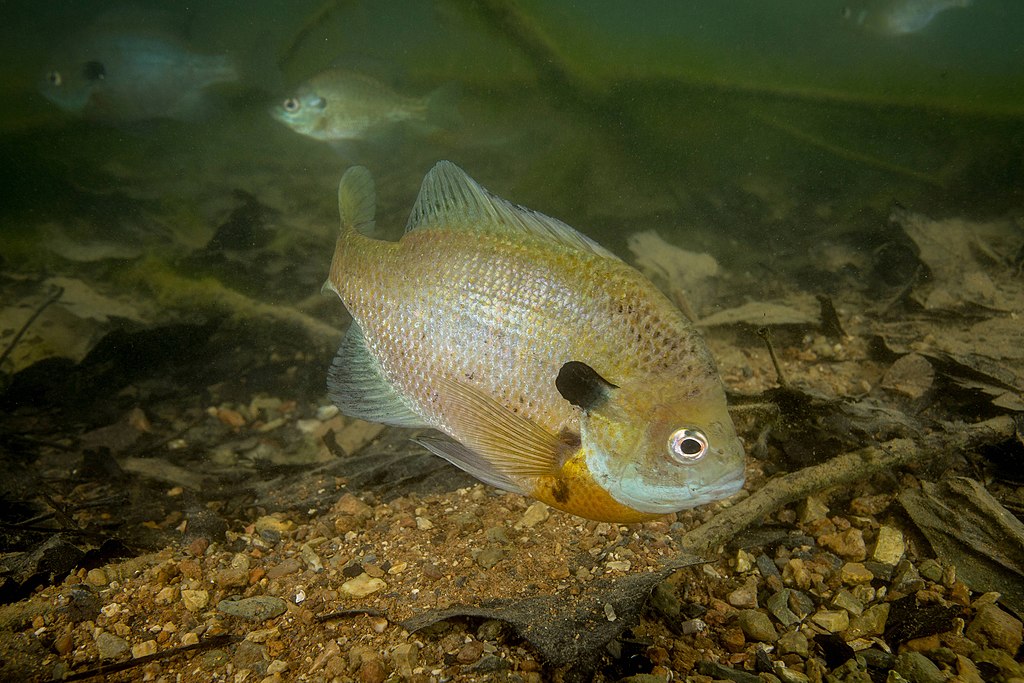
Bluegill
Scientific Name: Lepomis macrochirus
Also known as: Sunfish, Bream, Copperbelly, Brim, Blue Gill
General Description
The bluegill is one of the most popular and widely recognized species of freshwater fish in North America. Known for their vibrant coloration, bluegills exhibit a variety of hues, including shades of blue, green, and orange. They have a flattened, pan-shaped body, making them easy to identify. The most distinctive feature of bluegill is the dark spot located at the base of their dorsal fin and their small, pointed pectoral fins. Bluegills have a relatively short lifespan, typically living around 6 years, but they can grow up to 12 inches long, with some individuals reaching up to 15 inches in ideal conditions. Their weight usually ranges between half a pound and a pound, but larger fish can exceed 2 pounds.
Bluegills are considered opportunistic feeders, preying on a variety of food sources, such as small fish, insects, and crustaceans. They are also a popular target for anglers due to their abundance and willingness to bite, making them ideal for beginners or seasoned fishermen alike. Bluegills are typically caught using light tackle, making them an enjoyable challenge. These fish tend to congregate in schools, often found near submerged structures, such as weeds, rocks, and drop-offs.
Where to Find Them
Bluegill sunfish are widely distributed across North America, particularly in the eastern United States, the Great Lakes region, and parts of the Midwest and South. They inhabit both still and slow-moving waters, such as lakes, ponds, reservoirs, and rivers. Bluegills are adaptable to a range of habitats, from clear to murky waters, and can be found in both shallow and deeper areas of a water body, depending on the time of year and environmental conditions.
During the warmer months, bluegills are most often found near shallow areas, where they can seek shelter under submerged vegetation and rocks. They tend to prefer warm waters, with temperatures ranging from 65 to 80°F, and are typically found in depths of 5 to 15 feet. During the spawning season, bluegills move closer to shore and nest in sandy or gravelly areas, often near submerged structures. They are known to be especially abundant in reservoirs and man-made ponds, where they thrive in calm, shallow waters with plenty of plant cover for hiding and feeding. In rivers and streams, bluegills are often located near slower-moving pools or behind submerged rocks and logs.
Bluegills are also known to move with the seasons, relocating to deeper waters during colder months, such as the winter, and returning to the shallows when temperatures rise. Whether fishing from the bank, a boat, or a pier, anglers can often find bluegills near areas with submerged cover, such as weed beds, sunken timber, and drop-offs.
Best Baits
Live Bait Options
- Live worms (earthworms, red worms)
- Crickets
- Grasshoppers
- Small minnows
- Insects (especially beetles)
Artificial Bait Options
- Soft plastics (jigging worms, grub baits)
- Small crankbaits
- Spinnerbaits
- Artificial flies
- Small jigs
Best Fishing Methods
Bluegills are relatively easy to catch, thanks to their active nature and tendency to school in large numbers. One of the most popular fishing methods for bluegill is still fishing with live bait, especially when using worms or crickets. Anglers often fish near submerged structures, such as weed beds, drop-offs, or sunken timber, where bluegills like to hide. A simple float or bobber rig can be effective for suspending the bait at the right depth and attracting bluegills.
Casting small jigs or soft plastics near these structures is also a successful technique, especially when bluegills are feeding in the shallows during the warmer months. When fishing with artificial lures, it’s important to use lighter tackle to mimic the movement of small prey, which bluegills find most appealing. Jigs and spinners in natural colors (like green, brown, and orange) work well for bluegill, as do small minnows or insects imitations.
Fly fishing is another effective method for catching bluegills, especially when they are feeding near the surface. Small poppers or wet flies in bright colors can attract bluegills, especially during the warmer months when they tend to be more active near the surface.
When bluegills are in deeper waters, a slow retrieval of a small jig or plastic worm can be successful. The key to success when fishing for bluegills is using light tackle and maintaining a slow, steady retrieve to avoid spooking the fish. Anglers should also consider fishing during dawn or dusk, when bluegills are more actively feeding.
Summary
Fishing for bluegill is an enjoyable and accessible experience for anglers of all skill levels. With their abundance and willingness to bite, bluegills are often the first species that many anglers target when learning to fish. They are commonly found in shallow, warm waters during the spring and summer months, particularly near submerged structures like weeds, rocks, and sunken logs.
Bluegills are opportunistic feeders, making them relatively easy to target with live bait, such as worms, crickets, and small minnows, or artificial baits like jigs and small crankbaits. The best fishing methods involve still fishing with a bobber rig, using light tackle to mimic the movement of natural prey. Fly fishing can also be effective, particularly when bluegills are feeding near the surface. Fishing for bluegills can be productive year-round, with the best times being in the warmer months, especially early in the morning or late in the evening.
While they may not grow to the large sizes of other species, bluegills offer a fun, challenging, and rewarding experience, especially for anglers who enjoy fishing with light tackle. Whether you’re a beginner looking to get started or an experienced angler targeting this species, bluegill fishing offers something for everyone. With plenty of opportunities to catch them in lakes, ponds, and rivers, bluegills remain a favorite among freshwater fishermen.


